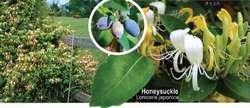honeysuckle
1. any temperate caprifoliaceous shrub or vine of the genus Lonicera: cultivated for their fragrant white, yellow, or pink tubular flowers
2. any of several similar plants
3. any of various Australian trees or shrubs of the genus Banksia, having flowers in dense spikes: family Proteaceae
Collins Discovery Encyclopedia, 1st edition © HarperCollins Publishers 2005


honeysuckle
honeysuckle
Be careful, some are poisonous, some are not and it’s hard to tell them apart. There are almost 200 varieties, it would take a whole book to discuss the differences. A vine that stays green all year. Upturned white flowers that turn yellow. NOTE: Some varieties have berries that are highly poisonous - Do not eat them! Japanese Honeysuckle (Lonicera japonica), is one of the edible variety. Extremely fragrant edible 2-lipped white/yellow flowers that are a bit purple or pink when young. Simple-shaped opposite leaves. Grows as a vine/bush. Fruit is blue/black berry-like with 3-5 stones. Leaves, stems, flowers edible. Antibacterial, anti-inflammatory, antispasmodic, reduces blood pressure, rheumatoid arthritis, hepatitis, upper respiratory infections, pneumonia, tumors, skin diseases, rashes, cholesterol, viruses. Even used for tuberculosis. Compounds so strong, they are toxic to fish and some animals. Plant grows aggressively and can take over an entire building if left alone. Be sure you know which type you are dealing with before consuming.
Edible Plant Guide © 2012 Markus Rothkranz
honeysuckle
symbol of affection. [Flower Symbolism: Flora Symbolica, 174; Kunz, 328]
Allusions—Cultural, Literary, Biblical, and Historical: A Thematic Dictionary. Copyright 2008 The Gale Group, Inc. All rights reserved.
The following article is from The Great Soviet Encyclopedia (1979). It might be outdated or ideologically biased.
Honeysuckle
(Lonicera), a genus of shrubs (sometimes climbers) of the family of Caprifoliaceae. The leaves are opposite, simple, and either deciduous or evergreen. The flowers may be white, yellow, pink, or red, and are arranged in pairs or whorls; sometimes they are gathered in capitate or spicate inflorescences. The corolla is five-lobed, bilabiate, and tubular. The fruits are juicy berries, growing separately or in pairs and somewhat fused. Honeysuckle grows in underbrush, requires considerable sunlight, and is used in landscaping. The wood is used for making small objects. There are over 200 species, growing chiefly in the northern hemisphere; in the southern hemisphere honeysuckle may be found in the Andes. In the USSR there are 51 species, growing in the Caucasus, Middle Asia, Siberia, and the Far East. The most important species are the fly honeysuckle (L. xylosteum)\ the Tatar honeysuckle (L. tatarica) with bare grayish leaves, growing from the Volga to the Enisei; the blue honeysuckle (L. coemlea) found in the Carpathians; and the edible honeysuckle (L. edulis), with tart black berries, growing in the Far East and in eastern Siberia. The Caucasian honeysuckle (L. caucasica) and the perfoliate honeysuckle (L. caprifolium) grow in the Caucasus.
The Great Soviet Encyclopedia, 3rd Edition (1970-1979). © 2010 The Gale Group, Inc. All rights reserved.
